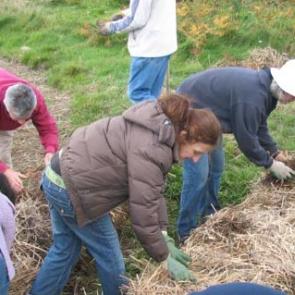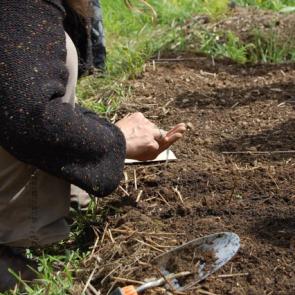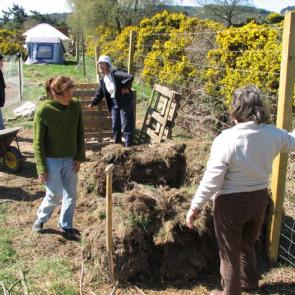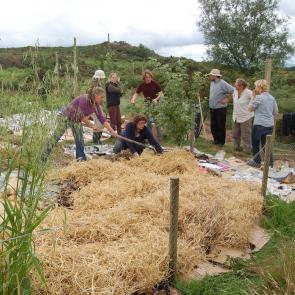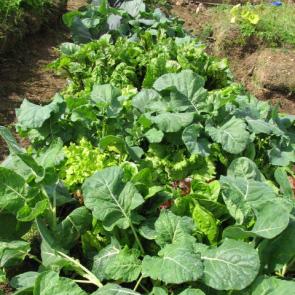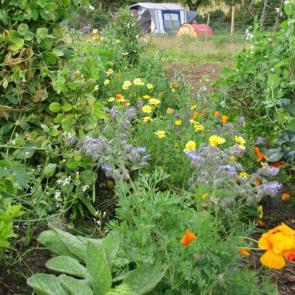Submitted by suzie on

Permaculture design creates systems that are closed loops or circular rather than linear. One feature of this approach is that it avoids inputs and outputs travelling long distances. Working with nature means finding ways to cycle nutrients in a local system. However, at first there can be a lot of regeneration and repair work needed for degraded land, like ours was, when we started at Carraig Dúlra 10 years ago.
We began by building the soil structure adding bulk organic matter. Our focus was on feeding the soil life as a vital part of regenerating our soil, as well as the mycelium or fungal networks in the soil so that they could work symbiotically to feed plants.
Living near the coast, we gathered a lot of seaweed for our first garden, the Circle Garden, made up of blocks of lazy beds. These types of beds were made traditionally, in Ireland and around the world, and are very suitable for permaculture gardening as lazy beds disturb the soil minimally. They are made by creating a soil sandwich with manure and seaweed in the middle by turning whole sods on top of them.
As can been seen in the banner pictures 10 years apart (in the first our youngest Finn and I are on a beach in Bray, Co Wicklow and the second Mike and I are on Carne beach, Co Wexford), we still collect seaweed today as a top dressing on beds before annual brassicas or onto seaside perennials such as sea kale. It is our way of helping to create a cycle of return for minerals and nutrients from the sea as human waste streams are eroding them from the land into the sea.
We set up of lots of compost heaps to receive compost materials from mainly off site waste in the first year. We had about 13 heaps taking unwanted kitchen and garden waste from friends and family. We also brought in waste in the form of mulch materials, old straw, cardboard and paper, but also used the local bracken and leaf mould. In the global economy this approach actually brings nutrients from farther a field or far off fields when the waste is from people eating non-local diets and cardboard or paper harvested from trees far away.
In those early years, we were always on the search for well rotted animal manures from nearby farms. Some of it was very well rotted indeed: 30 year old sheep manure got us very excited when found in an old shed, and a similarly aged horse manure heap took us many trailer runs to bring on site. Our visitors also made deposits that were composted and still do. This addresses annother linear system where humans eat fertility from the land and current sewage systems mean that all ends up in the oceans. We tried to use our fossil fueled car and trailer runs wisely investing oil into soil.
However, as the soils slowly regenerated, and as new ground was cleared (sometimes with the help of pigs) we honed the system.
We now add our own poultry manure (we've hens and ducks) to our compost systems making the fertility more local. Our compost system is made up our recipe of garden and kitchen wastes, picked over by the hens, layered with some seaweed, crushed charcoal to bio-activitate it, poutry bedding is added in small layers and a small amounts of wood ash and urine too. So far we haven't used much lime or calcified seaweed or rock or coral dust but will be sending off soil samples to check our nutrients shortly and may consider more use for the annual gardens. Our PH is acid but we are making use of that by growing many many acid lovers like blueberries and other plants, trees and shrubs.
Bare soil is not left bare for long. It is either covered with crops, compost, various other mulches, or green manures and other nutrient fixing plants or dynamic accumulators (deep tap rooted plants that draw up nutrients). We chop and drop mulches grown in the in the forest gardens like willow leaves and bamboo and comfrey. We set up a micro biogas digester that gives us gas and liquid fertiliser to add to the comfry, nettle, worm and compost teas that we add to soil periodically to help stimulate and activate soil life.
In addition, we have hydrated our free draining, sandy soils, by creating pond and swale systems (more on these in another blog later this year.)
The pictures should give an idea of the before and afters of all this soil care and repair work building to our our current yields of healthy fruit, vegetables and herbs. These yields: the healthy nutrient rich food our family, course, participants, volunteers and customers get along with the livestyle choices they encourage are the abundant return on our investment in soil. A better return than most these days we think.





